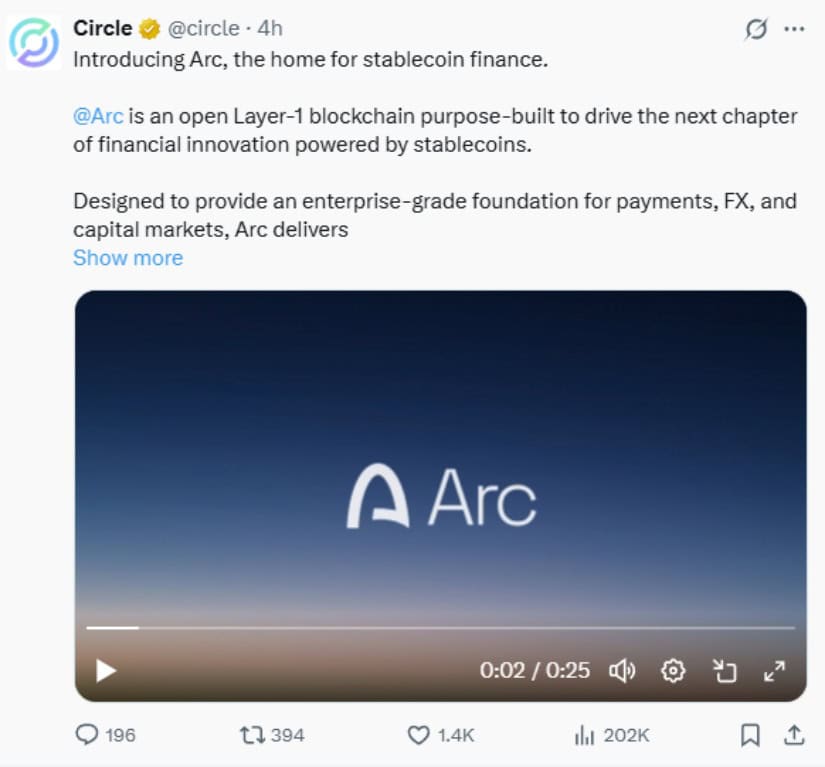Circle Launches Arc: A Game-Changing Blockchain Built for Stablecoin Dominance
Stablecoin giant Circle just dropped a bombshell—and TradFi banks won't like it.
Arc, their new purpose-built blockchain, is a direct shot across the bow of legacy finance. No more grafting stablecoins onto general-purpose chains. This is a rails-up redesign for institutional-scale settlements.
Why it matters: USDC's backers are done asking permission. While Wall Street debates 'regulated blockchains,' Circle's deploying infrastructure that could make them irrelevant. The play? Own the plumbing for the next trillion in tokenized assets.
Bonus dig: Because nothing says 'financial revolution' like rebuilding the exact same system—but with 24/7 settlement and blockchain buzzwords.

Circle, the company behind the popular USDC stablecoin, announced on August 12, 2025, that it will launch its own blockchain network called Arc. This new layer-1 blockchain focuses entirely on stablecoin payments and financial services, marking a major shift in how digital dollar transactions could work.
What Makes Arc Different
Unlike other blockchains that handle many types of digital assets, Arc is built specifically for stablecoins – cryptocurrencies that maintain steady value by being backed by real-world assets like US dollars. The most notable feature is that users will pay transaction fees directly with USDC instead of volatile crypto tokens.
Arc will be compatible with Ethereum’s VIRTUAL Machine, meaning developers can use the same tools and programming languages they already know. The blockchain promises sub-second transaction finality and can handle up to 3,000 transactions per second with 20 validators, or up to 10,000 transactions per second with just four validators.

Source: @circle
The network includes a built-in foreign exchange engine for institutional trading and optional privacy features that let users hide transaction amounts while keeping addresses visible. These features target businesses that need predictable costs and regulatory compliance.
Strong Financial Performance Drives Expansion
Circle’s decision to build Arc comes during a period of impressive business growth. In the second quarter of 2025, the company reported total revenue of $658 million, up 53% from the same period last year.
USDC circulation reached $61.3 billion by the end of June, representing 90% growth year-over-year. By August 10, 2025, USDC had grown even further to $65.2 billion in circulation across 24 different blockchain networks.
Despite strong revenue growth, Circle posted a net loss of $482 million in Q2, primarily due to $591 million in non-cash charges related to its June 2025 initial public offering. The company raised $1.2 billion in its stock market debut, making it the first major crypto company to go public since Coinbase in 2021.
Timeline and Technical Details
Arc will enter private testing in the coming weeks, with public testing scheduled for fall 2025. The full mainnet launch is planned for 2026, giving developers and businesses time to prepare their applications.
The blockchain uses a consensus mechanism called Malachite, developed by Informal Systems. Circle recently acquired the Malachite team to help build and maintain Arc. The Core software will be released under an open-source license, allowing other developers to contribute improvements.
Arc will integrate with Circle’s existing products, including the Circle Payments Network launched in May 2025, which already serves financial institutions across four payment corridors. More than 100 financial institutions are reportedly in the pipeline to join the network.
Industry Reaction and Concerns
Not everyone in the crypto community welcomes Arc’s launch. Some experts question whether another blockchain is necessary, especially one focused solely on stablecoins.
Columbia Business School professor Omid Malekan argued that stablecoins might struggle on a dedicated blockchain without diverse digital assets and strong decentralized finance applications. Adam Cochran from Cinneamhain Ventures criticized Arc’s validator structure, calling it more of a “consortium chain” with pre-approved validators rather than a truly decentralized blockchain.
Cochran pointed out that using USDC as the native token removes economic incentives for independent validator behavior, potentially making the network more centralized than traditional blockchains.
Growing Competition in Blockchain Infrastructure
Circle’s Arc launch reflects a broader trend of companies building their own blockchain networks. Payment giant Stripe is reportedly developing a blockchain called Tempo with crypto venture firm Paradigm. Trading app Robinhood launched its own layer-2 blockchain for tokenization in June 2025.
The regulatory environment has also become more favorable for stablecoins. The GENIUS Act, passed in 2025, created a federal framework for payment stablecoins in the United States. This regulatory clarity has encouraged more companies to explore blockchain-based payment solutions.
Circle maintains that Arc will strengthen the broader blockchain ecosystem rather than compete with it. The company plans to continue supporting USDC on existing networks while using Arc to unlock new institutional use cases that current blockchains cannot serve effectively.
What This Means for Digital Payments
Arc represents Circle’s bet that specialized infrastructure will drive mainstream adoption of digital dollars. By solving common enterprise concerns about volatile gas fees, unpredictable costs, and privacy requirements, Arc could attract traditional financial institutions that have been hesitant to use existing blockchains.
If successful, Arc could accelerate the shift toward stablecoin-powered global payments. With USDC already processing trillions of dollars in annual transactions, a dedicated blockchain could significantly expand these volumes by serving enterprise customers who need regulatory compliance and predictable operations.

